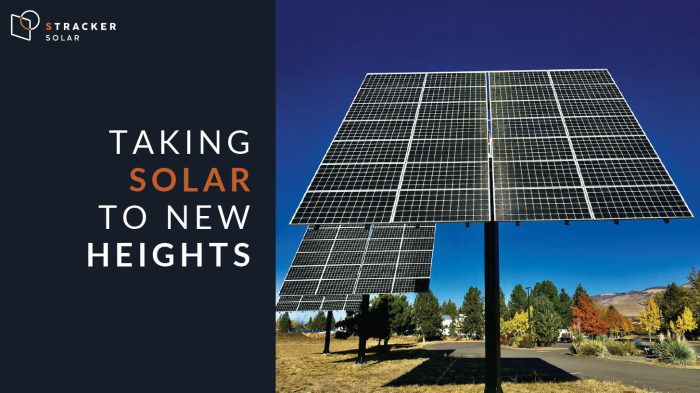
Rooftop solar doesn’t work for all customers, and conventional ground-mount and carport solar structures don’t fit all sites and project objectives. This is where elevated dual-axis solar trackers can come into play. Here to make the Pitch for elevated dual-axis trackers and the added value they can provide is Jeff Sharpe, Founder and COO of Stracker Solar.
0:29 – Overview of Stracker Solar as a company
1:20 – Three value adds of dual-axis trackers over single-axis trackers
2:19 – What is the foundation/structure of a Stracker tracker?
2:57 – Details of the tracking hardware and control system
5:00 – Failure points?
6:12 – Key segments for dual-axis solar trackers
7:12 – Comparison of 200 kW dual-axis solar project vs. rooftop solar
9:00 – Explanation of construction and panel installation
9:38 – How to start installing Stracker trackers
Read part of the transcript below, or watch the full episode right here:
Commonly when we think of trackers, we’re thinking of single-axis trackers that we see in those long rows out in the field that incrementally tilt and follow the sun. They require a lot of green space. Elevated dual axis-trackers are totally different. They’re pole-mounted structures. How much can an elevated dual-axis solar tracker support in terms of weight and kilowatts?
Trackers have at least three value adds over the typical single axis system. First are pole mounting lets us install in hilly or rocky terrains that might not be level enough for those conventional single-axis rows. Second, their 20-ft high control and actuator platform keeps all the mechanical and electrical systems well out of reach, so there’s no need for fencing.
And last but not least, their minimum 14-ft ground clearance allows continued use of the ground below for activities that range from farming with tractors and combines to industrial operations to school yards to parking lots where there’s room for semis and buses and fire trucks to pass below. That’s because of their 15-ft minimum ground clearance.
Stracker foundations typically consist of a simple 30-in. diameter pier foundation heavily reinforced. The pole bolts to this foundation so it can be relocated if needed and Strackers are built of American-made steel. We can get as many as 10 on a truck and our current model has an array of 28 450 Watt bifacial modules. So, they have a dc and an ac power rating of 12.6 kW, and we’re seeing that the bifacial gain is about seven percent on top of that.
Moving on to the tracking part of the dual-axis tracker, what is the hardware and how does that mechanism work?
The heart of this tracking system is our proprietary drive core that includes slew drive actuators, electric motors and an advanced control system. The drive core mounts right on top of the pole with a compact steel assembly and a structural bolting system. The control system incorporates the sophisticated, proprietary GPS-based algorithm. We don’t use any hydraulics, no linear actuators, just exceptionally high strength actuators and electric motors.
The trackers carry the coveted UL 3703 listing and are load tested for wind ratings of 120 mile an hour.
Taking all that into account, I assume that dual-axis trackers pole mounted like this means you’re totally unconcerned about site constraints.
Being relieved of site constraints is one of our value propositions, but really the power of dual-axis tracking is the ability to keep that array pointed directly at the sun. This is what gives Strackers their exceptional production efficiency. In this industry that highlights one percent efficiency increases, Stracker’s 70 percent we think is truly a game changer. And their elevation keeps them raised above typical dust flurries as well as the shade of nearby trees and buildings and it provides a wider background for bifacial gain.
What segments are you after?
We’re providing DG systems for the commercial and community solar markets, and we’re targeting the 200 kW to 2 MW project range. Our goal is to provide a novel solar approach for the EPCs to be more competitive and win more projects. We hope that by adding our pole mounted trackers to their portfolios, EPCs can secure projects where sites might otherwise have restrictions that make the traditional offerings not suitable.
Can you give me an apples-to-apples example of how a dual-axis solar tracker designed for a site compares to a rooftop or carport proposal? Let’s say it’s a car dealership looking to add 200 kW.
For comparison of power production, let’s look at a 200 kW Stracker installation versus a typical 200 kW carport installation. We’ve been testing and have data here at about our 40 degree latitude of Ashland, Ore., where we are — about the latitude of Chicago — where we are using the exact same modules, exact same inverters. The 200 kW Stracker installation, which by the way is 16 Stracker units, produces 480 MWh per year. If we take a carport system that we assume a 5 degree south facing tilt, that system will produce 280 MWh per year. From that, we see that the Stracker system produces a full 70 greater energy production each year.
Now, to be fair if you increase that tilt of that carport from 5 degrees to 15 degrees somewhere, then our energy harvest is only 50 percent greater than the carport. But oftentimes we’ll see east-west facing carports at 10 degrees, and that’s going to be equivalent to that five degree south.
Strackers will also show about a 65 percent lower greenhouse gas footprint per kilowatt hour produced, and that’s because the power coming from the PV modules is increased and each PV module accounts for more than 90 percent of the typical PV system’s embedded carbon.
— Solar Builder magazine
Leave a Reply
You must be logged in to post a comment.